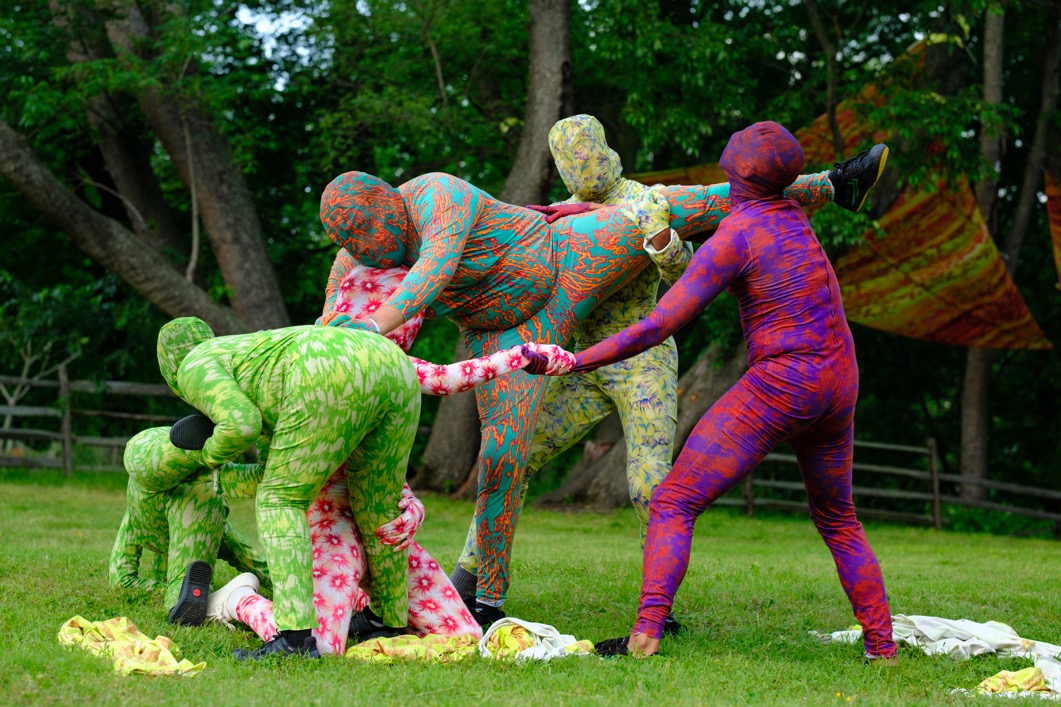
In Resistencia en el jardín, Mari Carmen Barrios sketches an expansive portrait of Joiri Minaya’s practice, framing her performance Venus Flytrap within a genealogy of Afro-descendant knowledge that Western botanical history has marginalized or silenced. The text unfolds between a sensorial chronicle of the performance at Bartram’s Garden, the reconstruction of colonial archives, and the analysis of Minaya’s visual and performative strategies, highlighting how her work activates a tension between visibility and opacity, eroticism and discipline, botanical knowledge and political resistance.
A figure quietly emerged from the bank of the Schuylkill River. She was covered, from the top of her head to her toes, by a kind of bright yellow full-body leotard, with a pattern that I couldn't make out from a distance. When she finished ascending the slope, with short, firm steps, she froze before the audience while the sound of a shovel digging into the earth resounded around us. It was one of the first days of summer in Philadelphia, and under the last rays of the sunset, people had settled into picnic blankets and beach chairs to wait for the start of Venus Flytrap, the latest work by Dominican-American artist Joiri Minaya.
The first figure was joined by five more, each ceremoniously ascending to the meadow between the tree trunks of Bartram's Garden, the oldest botanical garden in the United States, founded almost 300 years ago. One by one, the bodies formed a yellow tableau vivant in which faces and identities could not be distinguished. Already in formation, they began to shed their skin. The yellow tights were peeled back to reveal other, distinct tights underneath, with psychedelic patterns of green, purple, pink, orange, and turquoise. They wore gloves on their hands and hoods on their faces. They formed two or three more tableaux with their bodies, mixing colors, slowly coming alive through touch, and—just as I was formulating ideas about performance as a contained awakening—they broke loose.
Minaya's work spans almost all disciplines of visual art: photography, painting, drawing, video, and performance. Venus Flytrap is the artist's most extensive and complex project: a three-year research led by curator Dessane Lopez Cassell and BlackStar, a nonprofit organization dedicated to promoting film and audiovisual media by Black, Indigenous, and racialized artists. The program coincided with the Geographic Bodies exhibition, which brought together her most recent work at the Shelley and Donald Rubin Foundation's The 8th Floor gallery in New York. Together, Venus Flytrap and Geographic Bodies demonstrate the importance Joiri's work has gained in the American art scene and that it will undoubtedly continue to gain ground in Latin America and the Caribbean in the years to come.
The foundation of both projects—and what connects them—is a thorough exploration of Afro-descendant Caribbean ethnobotany, whose history encompasses a tradition of resistance to the slavery that marked the colonial era and the exploitation of modern imperialism. “There’s a lot of research behind the work that might not be obvious,” Joiri told me after the performance, as we waited for our dinner at an Ethiopian restaurant. “For this project [Dessane and I], we went to the archive of the Historical Society of Pennsylvania a lot. We reviewed [John] Bartram's papers and opened his botanical illustrations. That was fascinating,” Bartram, perhaps the most famous botanist of the British colonies in the 18th century, was a key figure in the study and propagation of plants from the American continent in Europe—among them magnolias, azaleas, and the maple tree—and his descendants continued the patriarch’s work until the end of the 19th century. Today, the botanical garden that bears his name makes an important effort to highlight the other stories—Indigenous, Black, and women's—of those who have also played a role in the propagation of plants around the world.
After the performance's subdued start, the performers dispersed, some slipping into the audience and others moving away from us, each seeming to respond to a different stimulus and moving to their own rhythm, sometimes moaning or puffing. Two of them, dressed in matching green tights, began a kinky improvisation, complete with twerking, involving members of the audience in the flirtation. It wasn't long before laughter and shouts started to break out among the audience, as their ease encouraged us. They approached me and asked if I wasn't feeling horny, and flattered but embarrassed, I replied that I was. The frenzy was fun but short-lived; the sound of the speakers faded away, and the performers began to gather once more, caressing each other. They finally lay down on the three-forked trunk of a canopy tree, like forest elves waiting for a traveler; all that was left was to admire their bodies encapsulated in those colorful tights, a hallmark of Joiri's work.
The history of botany has been a rich source for the discursive content of Venus Flytrap, inspired by the garden's academic research and recent educational projects dedicated to recognizing the importance of various plants to Afro-descendant populations in the Americas. Perhaps most particularly, the performance draws on the expertise and experience of those who managed to get African plants to grow on this continent, a difficult but easily overlooked task. The most well-known author on this topic is Judith Carney, whose fascinating book Black Rice (2001) conclusively demonstrated that rice plantations in the southern United States depended not only on enslaved labor, but also on the specialized knowledge of the African population whose rice farming techniques, brought from Africa, were adapted and exploited in the Americas. Since then, Carney and her colleague Richard N. Rosomoff have dedicated themselves to researching how African knowledge, after a few generations of African descent, allowed the transplantation and adoption of many other African species in the Americas and the Caribbean, which without the knowledge of the enslaved population would never have flourished on this continent.
Joiri makes a direct reference to two of these species, the castor oil plant [ricinus communis] and Saint George's sword [sansevieria trifasciata] (or “mother-in-law's tongue”, as I once heard in a nursery). Both were used for specific purposes: castor oil, for poisoning; and Saint George's sword, for preparing offerings and cleansings. These purposes are closely linked to the experience of slavery in the Caribbean, where the care or sabotage of one's own and other people's bodies represented one of the only possibilities for free action. The survival of these plants in the Americas indicates a desire for resistance and liberation among enslaved populations who, over the centuries, strove to ensure that these plants survived, reproduced, and spread, thus continuing to be useful to the Afro-descendant population. Unlike John Bartram, we don't know the names of these people, but the fruits of their efforts are evident and tangible. In the vacant lot next to the house where I'm writing this text, a huge castor oil plant grows among the grass.
While we were eating, the conversation with Joiri turned to fabric designs, a core aspect of her practice that she took up again for Venus Flytrap: “I think that in the past, perhaps because of the visual language, people were very confused about the issue of patterns. They didn't understand the distinction between whether I was creating the patterns or appropriating them and what the meaning of that distinction would be.” The designs for the tights, developed in collaboration with the Fabric Workshop and Museum in Philadelphia, are based on the patterns of the leaves of St. George's sword and castor bean seeds. The performers' somewhat erratic behavior seeks to emulate the effects that plants might have on those who consume them, thus linking the performative aspect of the work with the representation of botanical elements at the heart of the project and their broader oeuvre.
We finished eating and our conversation turned to Geographic Bodies, a sort of mid-career review, and its importance in shaping professional development in the art world: “I enjoy being listened to; that's the greatest achievement, especially after doing a lot of work that involves explaining oneself, or rather, not wanting to explain oneself.” This is because Joiri's collected works are so clearly focused on the concept of “opacity” by Edouard Glissant, whose thinking has become key in the contemporary art world. Glissant proposed opacity as a counterpoint to the transparency demanded of the individual in the Western world: identify yourself, know yourself, explain yourself. Opacity is the opposite: the individual resistance to making ourselves understood by those who are not our own. The patterned, full-body tights Joiri began making for her Containers series—in which she photographs herself completely wrapped in tropical patterns in gardens and bucolic settings—are a direct appeal to that idea: I refuse to be seen the way the world demands. The clarity of such a statement and my sympathy with the message are what, together, fuel my admiration for Joiri's work.
Geographic Bodies features what is perhaps my favorite of Joiri’s works, in which she connects a performative action to the pattern of the fabric designed for the performance: the photograph Encubrimiento (de la estatua de Cristobal Colon en el Parque Colon de la Ciudad Colonial en Santo Domingo, Republica Dominicana) [Cover-up (of the statue of Christopher Columbus in Colon Park in the Colonial City of Santo Domingo, Dominican Republic)] (2021), of the day the artist covered up Columbus, a nationalist monument—erected on the supposed site where the colonizer’s remains were found in the late 19th century—with a red spandex fabric printed with drawings made by the artist of plants described in Columbus’s letters to the Catholic Monarchs. The curators, George Bolster and Anjuli Nanda Diamond, very sensitively included all the parts that, together, formed the final work. On one wall of the gallery hang the seven botanical drawings of the plants—tobacco, achiote (or annatto), and guayacan—that make up the pattern; the fabric itself is displayed in a glass case. And in one gallery, a video of the performance, which took place one morning before the faint first light of day illuminated the performance preserved in the final photograph, is playing.
Covering Columbus's face with images of the fruits of the territory he subjugated seems to me to point toward an ecocritical dismantling of colonial history that will undoubtedly define the future influence of Joiri's work. Her work demonstrates how resistance to colonization incorporated botanical knowledge, which, in times of slavery, undoubtedly represented a valuable asset for African and Afro-descendant peoples on this continent. For me, Joiri's work is always a beautiful reminder that even in the most detestable condition—slavery—it is not possible to rob someone of the knowledge they have acquired through their own effort and lived experience. The African cooks, gardeners, midwives, and healers who lived enslaved on this continent bequeathed to their American descendants a vast knowledge of the uses of African plants for the care of—and also for the harm of—themselves and others. Joiri Minaya recognizes and celebrates what it means for this knowledge to have survived through time and generations: courage, community, and an unwavering determination to endure.
Before we said goodbye, I asked Joiri who else had joined us in the conversation, what thinkers or writers had animated the discussion without being explicitly mentioned. She told me about Alanna Lockward and Suzanne Cesaire, two Caribbean women from whom I read in the process of writing these reflections, but whose contributions perhaps have not yet been sufficiently recognized. The world has changed, and fortunately, Joiri isn't in that situation: two of her works have just entered the MoMA collection, and she has projects that will keep her busy in the coming years. “Knowing that there are people who are invested in what I have to say is very beautiful. My ideas resonating with other people happens to me at every exhibition, presentation, or talk. Someone comes to talk to me afterwards and tells me that the piece triggered something in them. It always impresses me.” There is no clearer example that Joiri Minaya is a fundamental artist of our times.

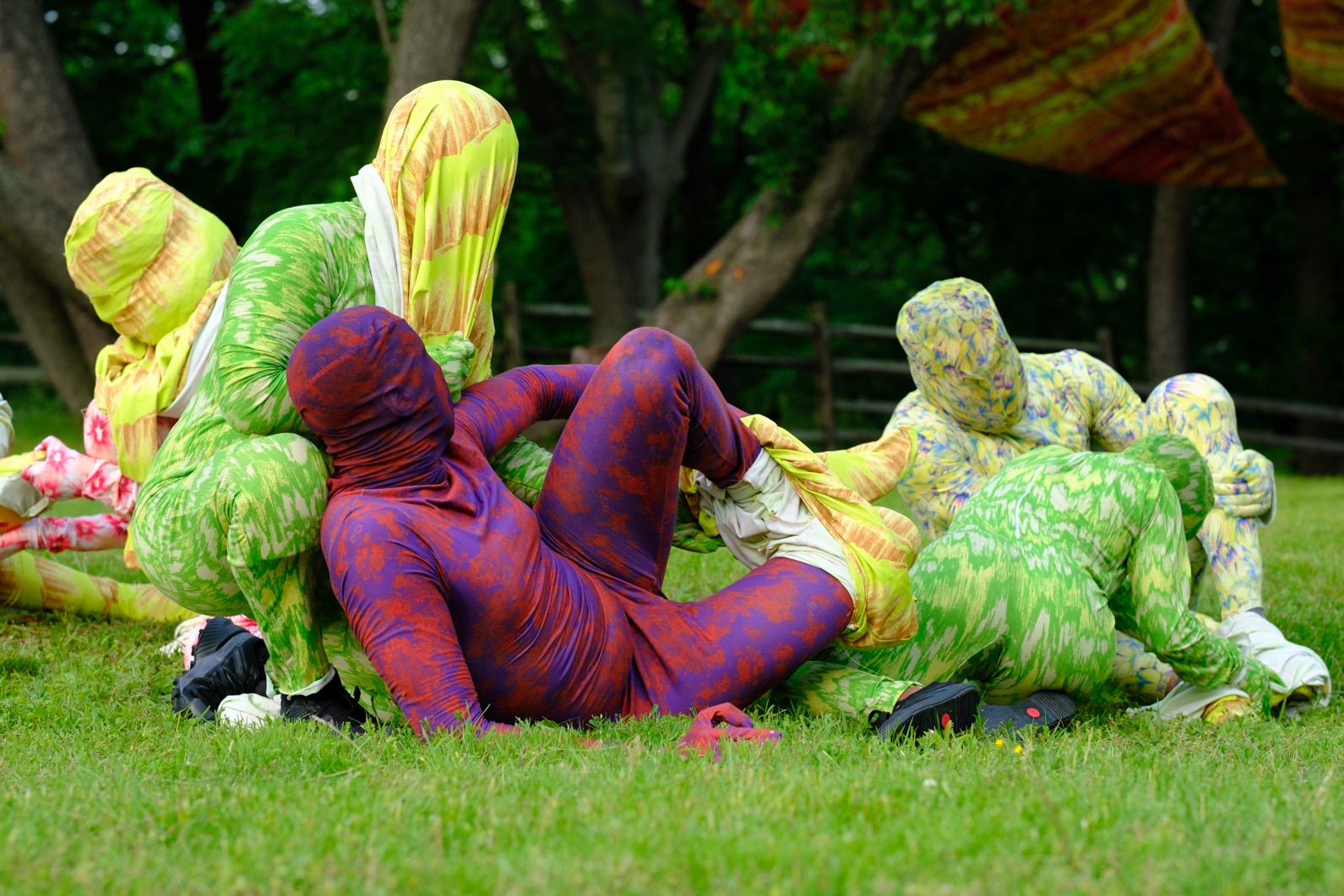
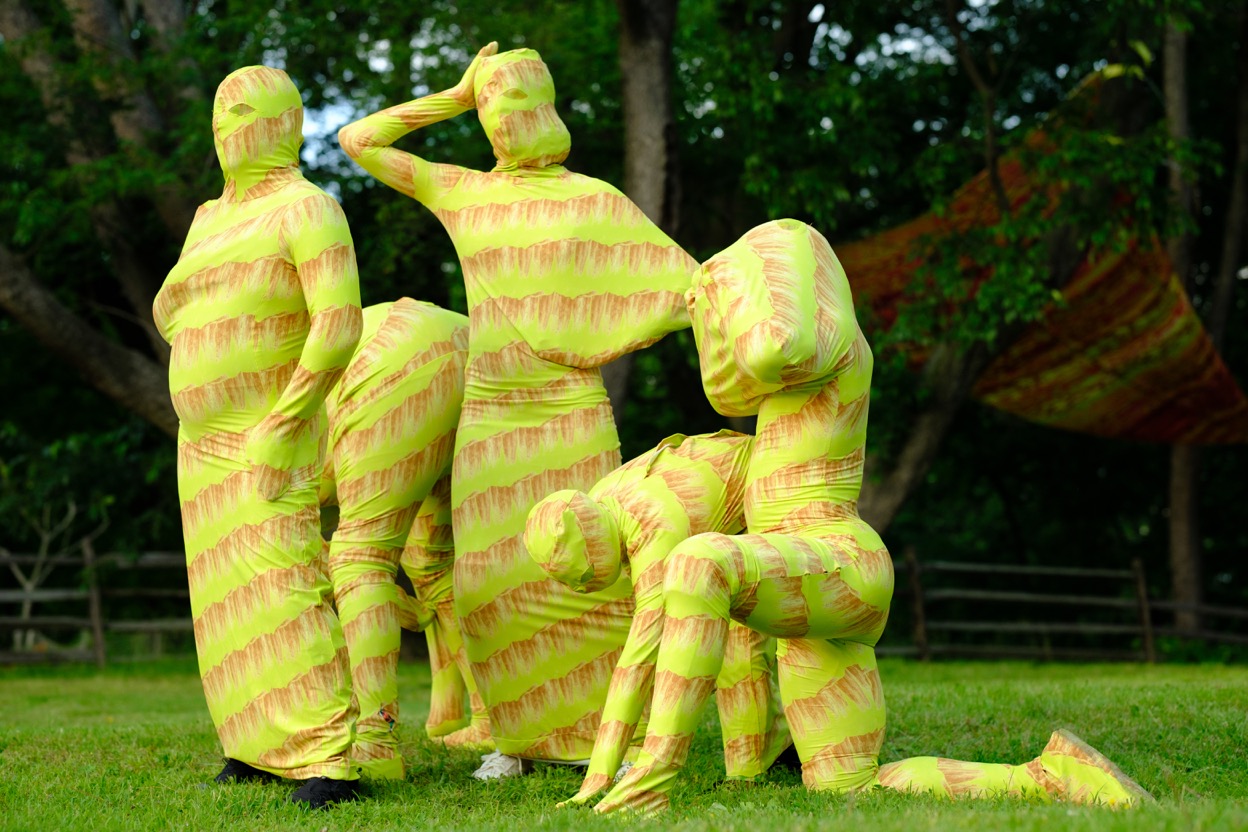
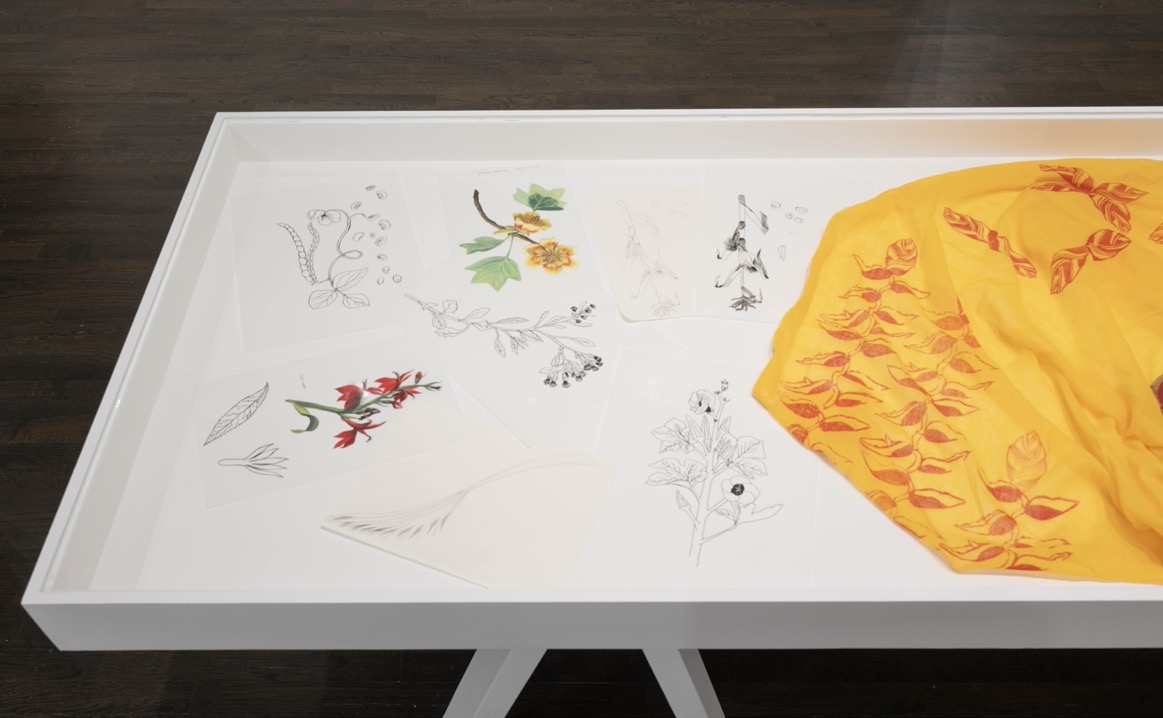
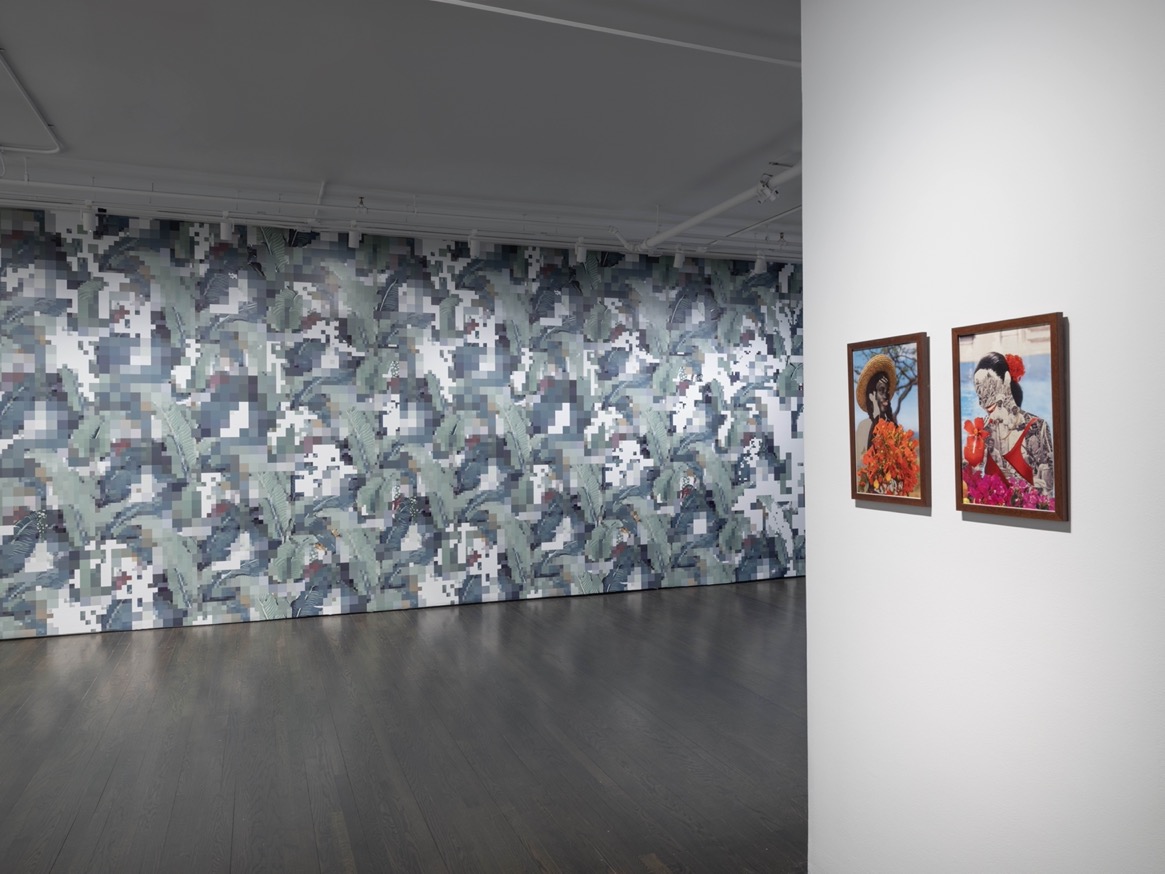
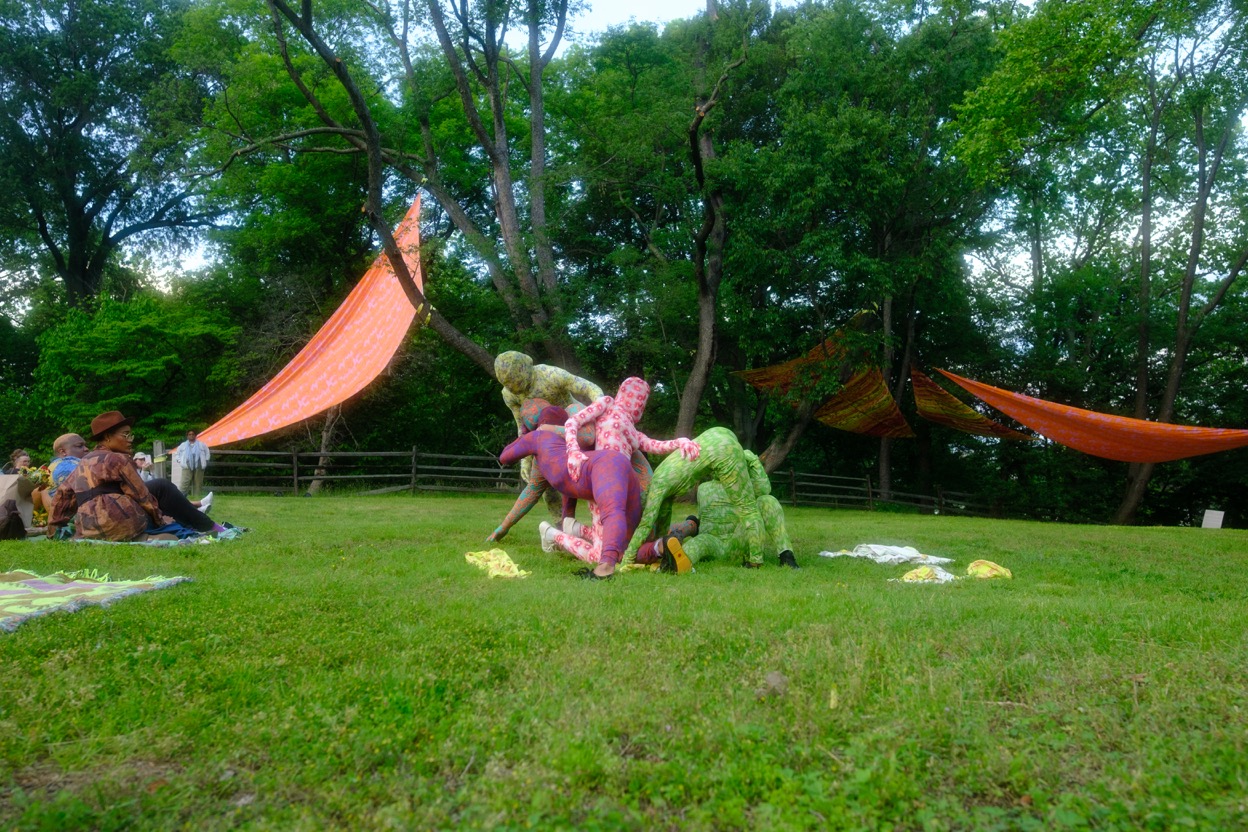

A figure quietly emerged from the bank of the Schuylkill River. She was covered, from the top of her head to her toes, by a kind of bright yellow full-body leotard, with a pattern that I couldn't make out from a distance. When she finished ascending the slope, with short, firm steps, she froze before the audience while the sound of a shovel digging into the earth resounded around us. It was one of the first days of summer in Philadelphia, and under the last rays of the sunset, people had settled into picnic blankets and beach chairs to wait for the start of Venus Flytrap, the latest work by Dominican-American artist Joiri Minaya.
The first figure was joined by five more, each ceremoniously ascending to the meadow between the tree trunks of Bartram's Garden, the oldest botanical garden in the United States, founded almost 300 years ago. One by one, the bodies formed a yellow tableau vivant in which faces and identities could not be distinguished. Already in formation, they began to shed their skin. The yellow tights were peeled back to reveal other, distinct tights underneath, with psychedelic patterns of green, purple, pink, orange, and turquoise. They wore gloves on their hands and hoods on their faces. They formed two or three more tableaux with their bodies, mixing colors, slowly coming alive through touch, and—just as I was formulating ideas about performance as a contained awakening—they broke loose.
Minaya's work spans almost all disciplines of visual art: photography, painting, drawing, video, and performance. Venus Flytrap is the artist's most extensive and complex project: a three-year research led by curator Dessane Lopez Cassell and BlackStar, a nonprofit organization dedicated to promoting film and audiovisual media by Black, Indigenous, and racialized artists. The program coincided with the Geographic Bodies exhibition, which brought together her most recent work at the Shelley and Donald Rubin Foundation's The 8th Floor gallery in New York. Together, Venus Flytrap and Geographic Bodies demonstrate the importance Joiri's work has gained in the American art scene and that it will undoubtedly continue to gain ground in Latin America and the Caribbean in the years to come.
The foundation of both projects—and what connects them—is a thorough exploration of Afro-descendant Caribbean ethnobotany, whose history encompasses a tradition of resistance to the slavery that marked the colonial era and the exploitation of modern imperialism. “There’s a lot of research behind the work that might not be obvious,” Joiri told me after the performance, as we waited for our dinner at an Ethiopian restaurant. “For this project [Dessane and I], we went to the archive of the Historical Society of Pennsylvania a lot. We reviewed [John] Bartram's papers and opened his botanical illustrations. That was fascinating,” Bartram, perhaps the most famous botanist of the British colonies in the 18th century, was a key figure in the study and propagation of plants from the American continent in Europe—among them magnolias, azaleas, and the maple tree—and his descendants continued the patriarch’s work until the end of the 19th century. Today, the botanical garden that bears his name makes an important effort to highlight the other stories—Indigenous, Black, and women's—of those who have also played a role in the propagation of plants around the world.
After the performance's subdued start, the performers dispersed, some slipping into the audience and others moving away from us, each seeming to respond to a different stimulus and moving to their own rhythm, sometimes moaning or puffing. Two of them, dressed in matching green tights, began a kinky improvisation, complete with twerking, involving members of the audience in the flirtation. It wasn't long before laughter and shouts started to break out among the audience, as their ease encouraged us. They approached me and asked if I wasn't feeling horny, and flattered but embarrassed, I replied that I was. The frenzy was fun but short-lived; the sound of the speakers faded away, and the performers began to gather once more, caressing each other. They finally lay down on the three-forked trunk of a canopy tree, like forest elves waiting for a traveler; all that was left was to admire their bodies encapsulated in those colorful tights, a hallmark of Joiri's work.
The history of botany has been a rich source for the discursive content of Venus Flytrap, inspired by the garden's academic research and recent educational projects dedicated to recognizing the importance of various plants to Afro-descendant populations in the Americas. Perhaps most particularly, the performance draws on the expertise and experience of those who managed to get African plants to grow on this continent, a difficult but easily overlooked task. The most well-known author on this topic is Judith Carney, whose fascinating book Black Rice (2001) conclusively demonstrated that rice plantations in the southern United States depended not only on enslaved labor, but also on the specialized knowledge of the African population whose rice farming techniques, brought from Africa, were adapted and exploited in the Americas. Since then, Carney and her colleague Richard N. Rosomoff have dedicated themselves to researching how African knowledge, after a few generations of African descent, allowed the transplantation and adoption of many other African species in the Americas and the Caribbean, which without the knowledge of the enslaved population would never have flourished on this continent.
Joiri makes a direct reference to two of these species, the castor oil plant [ricinus communis] and Saint George's sword [sansevieria trifasciata] (or “mother-in-law's tongue”, as I once heard in a nursery). Both were used for specific purposes: castor oil, for poisoning; and Saint George's sword, for preparing offerings and cleansings. These purposes are closely linked to the experience of slavery in the Caribbean, where the care or sabotage of one's own and other people's bodies represented one of the only possibilities for free action. The survival of these plants in the Americas indicates a desire for resistance and liberation among enslaved populations who, over the centuries, strove to ensure that these plants survived, reproduced, and spread, thus continuing to be useful to the Afro-descendant population. Unlike John Bartram, we don't know the names of these people, but the fruits of their efforts are evident and tangible. In the vacant lot next to the house where I'm writing this text, a huge castor oil plant grows among the grass.
While we were eating, the conversation with Joiri turned to fabric designs, a core aspect of her practice that she took up again for Venus Flytrap: “I think that in the past, perhaps because of the visual language, people were very confused about the issue of patterns. They didn't understand the distinction between whether I was creating the patterns or appropriating them and what the meaning of that distinction would be.” The designs for the tights, developed in collaboration with the Fabric Workshop and Museum in Philadelphia, are based on the patterns of the leaves of St. George's sword and castor bean seeds. The performers' somewhat erratic behavior seeks to emulate the effects that plants might have on those who consume them, thus linking the performative aspect of the work with the representation of botanical elements at the heart of the project and their broader oeuvre.
We finished eating and our conversation turned to Geographic Bodies, a sort of mid-career review, and its importance in shaping professional development in the art world: “I enjoy being listened to; that's the greatest achievement, especially after doing a lot of work that involves explaining oneself, or rather, not wanting to explain oneself.” This is because Joiri's collected works are so clearly focused on the concept of “opacity” by Edouard Glissant, whose thinking has become key in the contemporary art world. Glissant proposed opacity as a counterpoint to the transparency demanded of the individual in the Western world: identify yourself, know yourself, explain yourself. Opacity is the opposite: the individual resistance to making ourselves understood by those who are not our own. The patterned, full-body tights Joiri began making for her Containers series—in which she photographs herself completely wrapped in tropical patterns in gardens and bucolic settings—are a direct appeal to that idea: I refuse to be seen the way the world demands. The clarity of such a statement and my sympathy with the message are what, together, fuel my admiration for Joiri's work.
Geographic Bodies features what is perhaps my favorite of Joiri’s works, in which she connects a performative action to the pattern of the fabric designed for the performance: the photograph Encubrimiento (de la estatua de Cristobal Colon en el Parque Colon de la Ciudad Colonial en Santo Domingo, Republica Dominicana) [Cover-up (of the statue of Christopher Columbus in Colon Park in the Colonial City of Santo Domingo, Dominican Republic)] (2021), of the day the artist covered up Columbus, a nationalist monument—erected on the supposed site where the colonizer’s remains were found in the late 19th century—with a red spandex fabric printed with drawings made by the artist of plants described in Columbus’s letters to the Catholic Monarchs. The curators, George Bolster and Anjuli Nanda Diamond, very sensitively included all the parts that, together, formed the final work. On one wall of the gallery hang the seven botanical drawings of the plants—tobacco, achiote (or annatto), and guayacan—that make up the pattern; the fabric itself is displayed in a glass case. And in one gallery, a video of the performance, which took place one morning before the faint first light of day illuminated the performance preserved in the final photograph, is playing.
Covering Columbus's face with images of the fruits of the territory he subjugated seems to me to point toward an ecocritical dismantling of colonial history that will undoubtedly define the future influence of Joiri's work. Her work demonstrates how resistance to colonization incorporated botanical knowledge, which, in times of slavery, undoubtedly represented a valuable asset for African and Afro-descendant peoples on this continent. For me, Joiri's work is always a beautiful reminder that even in the most detestable condition—slavery—it is not possible to rob someone of the knowledge they have acquired through their own effort and lived experience. The African cooks, gardeners, midwives, and healers who lived enslaved on this continent bequeathed to their American descendants a vast knowledge of the uses of African plants for the care of—and also for the harm of—themselves and others. Joiri Minaya recognizes and celebrates what it means for this knowledge to have survived through time and generations: courage, community, and an unwavering determination to endure.
Before we said goodbye, I asked Joiri who else had joined us in the conversation, what thinkers or writers had animated the discussion without being explicitly mentioned. She told me about Alanna Lockward and Suzanne Cesaire, two Caribbean women from whom I read in the process of writing these reflections, but whose contributions perhaps have not yet been sufficiently recognized. The world has changed, and fortunately, Joiri isn't in that situation: two of her works have just entered the MoMA collection, and she has projects that will keep her busy in the coming years. “Knowing that there are people who are invested in what I have to say is very beautiful. My ideas resonating with other people happens to me at every exhibition, presentation, or talk. Someone comes to talk to me afterwards and tells me that the piece triggered something in them. It always impresses me.” There is no clearer example that Joiri Minaya is a fundamental artist of our times.







